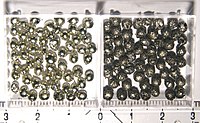
Photo from wikipedia
Tin-based materials with high specific capacity have been studied as high-performance anodes for Li-ion storage devices. Herein, a mix-phase structure of SnO-SnO2@rGO (rGO = reduced graphene oxide) was designed and… Click to show full abstract
Tin-based materials with high specific capacity have been studied as high-performance anodes for Li-ion storage devices. Herein, a mix-phase structure of SnO-SnO2@rGO (rGO = reduced graphene oxide) was designed and prepared via a simple chemical method, which leads to the growth of tiny nanoparticles of a mixture of two different tin oxide phases on the crumbled graphene nanosheets. The three-dimensional structure of graphene forms the conductive framework. The as-prepared mix phase SnO-SnO2@rGO exhibits a large Brunauer-Emmett-Teller surface area of 255 m2 g-1 and an excellent ionic diffusion rate. When the resulting mix-phase material was examined for Li-ion battery anode application, the SnO-SnO2@rGO was noted to deliver an ultrahigh reversible capacity of 2604 mA h g-1 at a current density of 0.1 A g-1. It also exhibited superior rate capabilities and more than 82% retention of capacity after 150 charge-discharge cycles at 0.1 A g-1, lasting until 500 cycles at 1 A g-1 with very good retention of the initial capacity. Owing to the uniform defects on the rGO matrix, the formation of LiOH upon lithiation has been suggested to be the primary cause of this very high reversible capacity, which is beyond the theoretical limit. A Li-ion full cell was assembled using LiNi0.5Mn0.3Co0.2O2 (NMC-532) as a high-capacity cathodic counterpart, which showed a very high reversible capacity of 570 mA h g-1 (based on the anode weight) at an applied current density of 0.1 A g-1 with more than 50% retention of capacity after 100 cycles. This work offers a favorable design of electrode material, namely, mix-phase tin oxide-nanocarbon matrix, exhibiting adequate electrochemical performance for Li storage applications.